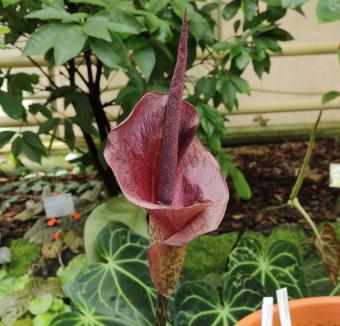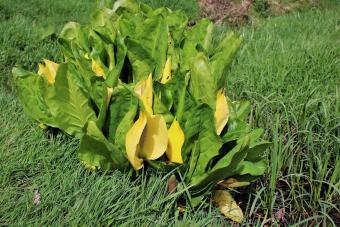
There is nothing like a lovely stroll through a flower garden, the sweet, fragrant scents of the blooms surrounding you, as if you're in the world's best spa. Nature's aromatherapy! Well... not always. Those sweet fragrances are usually for the benefit of attracting certain types of pollinators, and not all pollinators are attracted to what we'd generally consider "nice" scents. The plant world is full of stinky flowers, including both rare and more common plants.
Stinky Plants From Around the World
While there are many plants and flowers that smell bad that are usually only found in the wild or in the collections of botanical gardens, there are also plenty that you might consider growing in your own garden. Some are not exactly what you'd call attractive in the traditional sense of the word, but others are actually popular garden plants that might give you an unpleasant surprise.
Devil's Tongue

Known as either Devil's Tongue or Voodoo lily, the stinky flower of Amorphophallus konjac is native to south-central China and blooms once every 10 years or so. The bloom has the distinct, strong odor of rotting meat, which attracts certain pollinators. The odor lasts for several days, holding on even when the flower starts wilting.
Devil's tongue is hardy in Zones 6 through 11, and grows from thick, fleshy corms. Every year it sends up foliage, which doesn't have the same odor the flower does. It spends several years storing up energy in the corm before finally producing a flower stalk.
Corpse Flower

The corpse flower, also known as Titan arum (Amorphophallus titanum), is the largest flower in the world. It's also one of the, if not the, smelliest. Corpse flower blooms once every seven to nine years, and when its huge flower (which looks quite a lot like raw meat) opens, it emits a stench of death and rotten meat. The bloom only lasts for 24 to 36 hours before withering, after which the plant goes back to storing energy in its enormous corm for the next stinky bloom.
Corpse flower is native to the rainforests of Sumatra, Indonesia, and is considered to be an endangered plant, with fewer than 1,000 specimens still growing in the wild. Several botanical gardens also grow this stinky flower, so if you have one nearby, they're definitely worth checking out. Just.. maybe consider holding your nose if you decide to pay it a visit.
Bulbophyllum Phalaenopsis

When most people think of orchids, they think of graceful, delicate, arching blooms, maybe with a soft fragrance. Phalaenopsis bulbophyllum is not that kind of orchid. When it blooms, it produces multiple little inflorescences that are vaguely similar to the color of rotten meat, with an odor to match. But it gets weirder! Each little flower of this plant also produces pappilae, which are fleshy extensions that look like maggots are wriggling around on the stinky flowers.
The purpose of all of this flower stinkiness? It's attractive to the carrion fly, which are the primary pollinators of phalaenopsis bulbophyllum in the wild in its native habitat of Papua, New Guinea.
Carrion Plant

Carrion plant, Stapelia gigantea, is a succulent plant native to desert regions of Tanzania and South Africa that grows to about eight inches tall with thick, fleshy stems that can reach an inch and a half thick. These aren't the stinky part, though. No, that comes in fall, when shorter days trigger the plant to send up a flower stalk and bloom. Its yellow and red, wrinkly, star-shaped flowers are like big, stinky, desert-dwelling starfish, reeking of rotting meat.
The scent is, of course, to attract the flies, which are the chief pollinator of Stapelia gigantea. Between the scent, the color, and the large size of the flowers, the consensus is that this particular stinky plant is doing its best to appear as if it's a dead carcass, just waiting for flies to visit.
Crown Imperial

Also known as fritillaria or crown fritillary, this spring-blooming bulb is well known to many home gardeners. While it's undoubtedly beautiful, with its red, orange, or yellow bell-shaped flower clusters, this hardy plant (hardy in Zones 5 through 9) does have one drawback. Unless you enjoy the scent of skunk, that is.
The blooms of crown imperial have a distinctly musky, skunk-like odor. It's not nearly as offensive as some of the plants on this list, but still not something you'll want to get up close and personal with. Some gardeners consider the odor a bonus, since it keeps mice and other rodents, who don't like the smell, away from the garden.
Sea Holly

Sea holly (Eryngium) are unique flowers. The blooms, which are similar to those of teasel, are surrounded by spiky looking bracts available in striking blue, as well as white or silvery gray. They're tough plants: hardy in zones 4 through 9, drought-tolerant, thriving even in dry, sandy soil.
There is one drawback, however. The scent of sea holly flowers is, according to most gardeners, similar to that of cat or dog poo. So, not a great cut flower choice. But this odor seems to keep deer away, so if you have deer nibbling on your plants, you might want to consider planting some sea holly.
Lantana

Lantana is another plant that many gardeners would recognize, even if you haven't grown it. These bright, colorful plants are most often used in hanging baskets, containers, or as ground covers. Their bright, small flowers often have an almost fluorescent quality, providing a definite pop of color in the garden. It's also attractive to many pollinators, including several species of butterfly.
So, what's the drawback? Well, aside from being toxic to dogs, and being labelled as invasive in some areas (including Florida, Hawaii, and Arizona), it just... sort of stinks. The odor of lantana has been described as being like fermenting oranges, the scent of gasoline, or distinctly smelling like cat urine, depending on who's describing it, and some say it seems like a combination of at least a couple of those things. In this case, it's not the flowers that smell, but the foliage, especially if the leaves are crushed or the stems get broken, which releases that less-than-delightful scent.
Paperwhite Narcissus

Paperwhite narcissus is very popular around the holidays. You can purchase kits in just about any garden center or nursery that will allow you to force the bulbs to bloom indoors, just in time for Christmas. And they are undoubtedly beautiful. Those spring-like blossoms are a joy to behold in the middle of winter.
But the scent of paperwhite narcissus leaves something to be desired, at least as far as some people are concerned. While a certain portion of people think they smell just fine or not much at all, others cannot stand the scent. According to some, paperwhites smell like cat urine, or dirty socks, or just a general musky odor. This is due to a biochemical known as indole, which is present in many flowers, coal tar, and the fecal matter of animals. Whether it bothers someone or not seems to be more due to that person's own sensory response to it; two people can smell the same narcissus flower, and one might say it smells lovely while the other swears it's a stinky flower.
However, not all narcissus have an odor. If you like the look of paperwhites but the odor bothers you, look for a scent-free variety, such as 'Ziva,' which is available in catalogs and in some nurseries as well.
Pineapple Lily

Pineapple lilies (Eucomis) are annual flowers that grow multiple flower spikes with flower heads that look a lot like pineapple fruit, covered with small white or pink flowers. They grow from tender bulbs and bloom in late summer, sending up flower stalks that reach about 12 to 15 inches tall. They're gorgeous, unique, and easy to grow (though if you live in an area colder than Zone 8, you'll have to dig the bulbs up to overwinter them indoors.)
But, some varieties of pineapple lily smell like death. Literally. The scent is akin to that of a dead, decaying body, and, as you can guess, that's because the pineapple lily (like any flower, whether it's a stinky flower or not) is all about attracting pollinators. In this case, pineapple lilies are hoping flies will find them and pollinate away. According to garden writer Margaret Roach, there are some varieties that aren't stinky, such as 'Can Can' and 'Tugela Ruby,' but honestly, what's the point of growing a stinky plant if it doesn't actually stink?
Skunk Cabbage

If you want to grow a stinky plant that's native to most of the U.S., beneficial in multiple ways, and looks like something from an alien world, skunk cabbage might just be the plant for you. These plants, which emerge in early spring, sometimes appearing just as the snow is melting, grow best in wet, swampy areas. They're composed of a mottled, purplish-green spathe surrounding a central, usually yellow, spadix, which is covered with tiny flowers. Throughout the spring and summer, the plant sprouts more leaves, so that eventually, it looks like a large, weird cabbage.
Left on its own, it does have some odor, but not an overwhelming one. However, if it's stepped on or otherwise crushed, skunk cabbage releases an odor like rotting meat, which lures the insects that pollinate it. Believe it or not, the young leaves of skunk cabbage are actually edible, though that should only be attempted if you know what you're doing and have a reliable guide to show you which parts are safe, since most of the plant is toxic.
Dead Horse Arum Lily

Well. You can probably guess that the Dead Horse Arum Lily (Helicodiceros muscivorus) is another stinky plant that smells like death. This plant, which is native to Sardinia and Corsica, smells like rotting meat so that blowflies, which are a type of carrion fly and Helicodiceros' primary pollinator, will be attracted to it. Aside from its alluring scent, the dead horse arum lily is able to do something really weird. Yes, weirder than smelling like a dead horse: it can heat itself up. The term for this strange ability is thermogenesis, and it means that the plant can regulate its temperature; in this case, warm it up to make the flower even more inviting to flies.
And then there's the way it looks. There's really no polite way to say it, but the dead horse arum lily looks like a horse's... behind. The shape and coloration are a pretty close mimic to a pretty bad-smelling spot on a horse's body, just in case it wasn't clear that this plant really, really is all in on attracting flies.
The Weird and Wonderful World of Stinky Plants
While you might not want a flower arrangement with most of these flowers in them, there's no denying that they're interesting. They show just how diverse and mindboggling nature is, and illustrate how skillfully plants adapt to ensure their survival.







